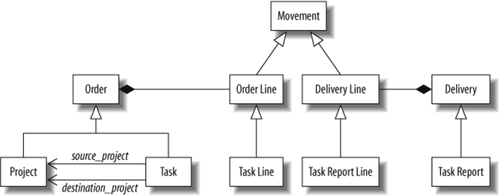21.4. ERP5 Project Concepts
To exemplify how ERP5 modules are coded, we'll spend most of the rest of this chapter exploring ERP5 Project, a flexible project management tool that can be used in many ways.
Due to the fast and competitive global business environment, projects are the usual form through which businesses develop innovative products and services. Therefore, project management is gaining interest in every industry segment.
But what is a project? According to Wikipedia, a project is "a temporary endeavor under-taken to create a unique product or service" (http://en.wikipedia.org/wiki/Project, last visited April 13, 2007).
The uniqueness of projects makes their management difficult, even for a small project sometimes. Hence the need for project management, which is "the discipline of organizing and managing resources in such a way that these resources deliver all the work required to complete a project within defined scope, quality, time, and cost constraints" (http://en.wikipedia.org/wiki/Project_management, last visited April 13, 2007).
Project management therefore must control a series of data related to resources such as money, time, and people to keep everything going as planned. Because of this, information tools are needed to ease the analysis of large amounts of data.
The first use for ERP5 Project was as an "internal" project management tool to support ERP5 instance creation projects. Afterwards, it was redesigned to support other types of projects in general. Even more broadly, this tool can manage order planning and execution wherever a project viewpoint can aid production planning and control. In other words, ERP5 Project should be adaptable to every situation where it is interesting to think in terms of a project composed of a series of tasks and limited by a series of constraints.
ERP5 allows the developer to reuse the current packages in delivering other packages as completely new modules. Following this concept, a new business template (BT) is created by basing it on an existing one.
By the time ERP5 Project started to be implemented, ERP5 already contained the Trade BT. The development team thus decided to base Project on Trade, representing the planning part of a project by reusing the logic developed for trading operations. After finishing the first Project version, they could improve the Project BT and then use the improvements to refactor Trade BT, making it yet more flexible.
In building Project, the interesting parts of Trade are the Order and Delivery classes. These classes, also part of the UBM, are containers for Order Line and Delivery Line objects, which in turn are Movements that contain ordered and delivered items, as shown in Figure 21-4. In that figure, the subclasses at the lowest level are all portal types. Therefore, they have basically the same structure as their superclasses, but each portal type has a different GUI and modifications in its workflow to act according to project management logic.
Figure 21-4. Relations between Trade and Project

The relation between Order and Delivery is maintained by causalities, which basically determine that for every confirmed order there will be a mirroring delivery sometime in the future. Tasks and task reports inherit the same behavior. Accordingly, order lines represent planned movements of resources between two nodes, which, after being confirmed, will be executed and generate delivery lines. Therefore, from a project management point of view, tasks implement project planning, and task reports implement project control.